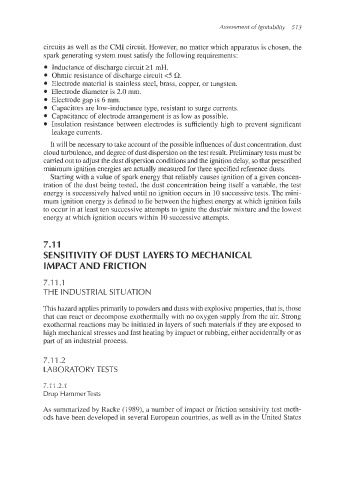Page 546 - Dust Explosions in the Process Industries
P. 546
Assessment of lgnitability 513
circuits as well as the CMI circuit. However, no matter which apparatus is chosen, the
spark generating system must satisfy the following requirements:
@ Inductance of discharge circuit 21 mH.
@ Ohmic resistance of discharge circuit <5 Q.
0 Electrode material is stainless steel, brass, copper, or tungsten.
@ Electrode diameter is 2.0 mm.
@ Electrode gap is 6 mm.
@ Capacitors are low-inductance type, resistant to surge currents.
6 Capacitance of electrode arrangement is as low as possible.
@ Insulation resistance between electrodes is sufficiently hgh to prevent significant
leakage currents.
It will be necessary to take account of the possible influences of dust concentration,dust
cloud turbulence, and degree of dust dispersion on the test result. Preliminarytests must be
carried out to adjust the dust dispersion conditions and the ignition delay, so that prescribed
minimum ignition energies are actually measured for three specifiedreference dusts.
Starting with a value of spark energy that reliably causes ignition of a given concen-
tration of the dust being tested, the dust concentration being itself a variable, the test
energy is successively halved until no ignition occurs in 10 successive tests. The mini-
mum ignition energy is defined to lie between the highest energy at which ignition fails
to occur in at least ten successive attempts to ignite the dudair mixture and the lowest
energy at which ignition occurs within 10 successive attempts.
7.1
SENSITIVITY OF DUST LAYERS TO MECHANICAL
IMPACT AND FRICTION
7.1 1.1
THE INDUSTRIAL SITUATION
This hazard applies primarily to powders and dusts with explosive properties, that is, those
that can react or decompose exothermally with no oxygen supply from the air. Strong
exothermal reactions may be initiated in layers of such materials if they are exposed to
high mechanical stresses and fast heating by impact or rubbing, either accidentally or as
part of an industrial process.
7.1 1.2
LA50RAT0RY TESTS
7.1 1.2.1
Drop HammerTests
As summarized by Racke (l989), a number of impact or friction sensitivity test meth-
ods have been developed in several European countries, as well as in the United States

